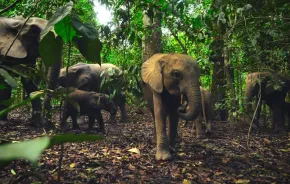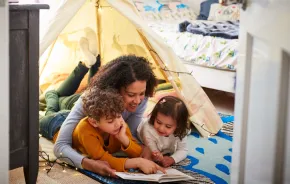
In the U.S., many family films are adaptations of books and often times, the consensus is that the book was better. Fortunately, exceptions to the rule can bring a favorite story to life, or inspire a child to a pick up a book outside of their reading wheelhouse. Sometimes both the movie and the book on which it’s based (like “The Secret of Moonacre” and its source “The Little White Horse”) are obscure; other times both the book and the movie are well known (think “Hunger Games”). Here are our recommendations for putting a literary twist on family movie night. It might just send your kids straight to the bookshelf when the credits roll.
General age recommendations are given, but every child is different. Check Common Sense Media or the IMDb Parents’ Guide for specific information about each film that will help you determine whether the movie is appropriate for your children.
1. "Cloudy with a Chance of Meatballs"
It’s a risky proposition to build an entire movie on a picture book, and "Cloudy with a Chance of Meatballs" by Judi Barrett is slim even by picture-book standards. The book can be summarized in one sentence: One morning Grandpa tells a funny story about falling food. But the PG movie is a tightly plotted celebration of individuality with subplots of father/son relationships and government corruption. Without sacrificing the goofiness of the source material, Cloudy … squeezes in pointed jabs at celebrity culture and immigrant stereotyping. The movie is as stuffed as the book is slender, but dare I say it? It’s better than the book.
Age rec: Common Sense Media recommends it for ages 6 and older, but even my easily-frightened daughter would have enjoyed this movie in preschool.
2. "Charlotte’s Web"
The beloved chapter book "Charlotte’s Web" by E.B. White leaves no room for improvement, which makes it all the more impressive that the book has been thoughtfully adapted not once, but twice, into family films that capture the spirit of one humble pig. The 1973 classic animation voiced by Debbie Reynolds and Henry Gibson continues to delight. But the 2006 live-action reboot with Dakota Fanning as young Fern also remains true to the source material with an all-star voice cast that includes Julia Roberts, Robert Redford, Cathy Bates and more.
Age rec: Common Sense Media approves both versions for ages 5 and older, but I'd recommend this gentle classic for all ages.
3. "The Tale of Despereaux"
Adaptation from text to visual format involves changes by necessity; but the measure of a good adaption is usually its faithfulness to the book. The animated movie based on Kate DiCamillo’s "Tale of Despereaux" has almost nothing in common with the book — only DiCamillo’s delicate, lyrical way of presenting hard truths and complex concepts for a very young audience. The plot may be greatly altered, but both book and film beautifully illustrate the battle between light and dark that takes place inside of every heart, and the way fear can steer us away from our best selves.
Age rec: Common Sense Media recommends this film for ages 6 and older, and in this case I agree. Although there is no real on-screen violence and everyone is ultimately redeemed, note that some scenes are visually ominous and the film can be intense for very young viewers.
4. "Bridge to Terabithia"
Caution: This recommendation contains spoilers! It’s a convention of children’s literature that primary characters always live to see a happy ending. When I was in fourth grade, Katherine Paterson changed my world forever with "Bridge to Terabithia," a children’s book in which a main character dies and the only happy ending is for her best friend to find the strength to go on living. It’s a discovery that can only be made once, so think carefully about whether you want your kids to read the book or see the movie first. I didn’t think a movie could capture the beauty of the unlikely sixth-grade friendship between Jess Aarons and his new neighbor, Leslie Burke. But in the 2007 film that combines live action with CGI-animation, a young Anna-Sophia Robb perfectly embodies Leslie, the free spirited child of urban intellectuals. Josh Hutcherson (better known today as hunky Peeta in "The Hunger Games") captures the ache of a sensitive boy in a hardscrabble life.
Age rec: Common Sense Media recommends it for children ages 9 and older, but round up if your child is emotionally sensitive. The movie is as good as the book, which means there will be tears, and they might not all be coming from your child.
5. "Holes"
With more than hint of magical realism, Louis Sachar’s intergenerational tale movingly confirms that even the most hopeless loser has worth, and everyone needs someone to show faith in them if they are to reach their potential. Sigourney Weaver is delightful as the nemesis to a young Shia LaBeouf in this movie dealing with many different aspects of justice. "Holes" moves back and forth in time, showing how one wrong act can continue to cause suffering for generations. The moral medicine goes down easily though, because it is well coated in acerbic humor that, like preteen boys themselves, constantly hovers on the edge of inappropriate.
Age rec: An act of race-based violence committed in the past is central to the plot, resulting in a Common Sense Media recommendation for ages 10 and older.
6. "Fantastic Mr. Fox"
There are two camps when it comes to the idea of a Wes Anderson movie based on a Roald Dahl book. The first camp will skip immediately to the next listing; the second already owns the film. If you find yourself unsure which camp you belong to, know that Roald Dahl is the wry, oft-banned children’s author responsible for classics like "Charlie and the Chocolate Factory," "James and the Giant Peach" and "Matilda." Wes Anderson is the filmmaker behind a series of spare, highly stylized (some might call them pretentious and twee) films including "The Royal Tenenbaums," "Rushmore" and "Moonrise Kingdom." Anderson's adaptation of Mr. Fox uses many of his favorite actors and displays his symmetrical aesthetic and dry, dry humor. But the animation and child’s storybook plot make this his most widely appealing film.
Age rec: Common Sense Media recommends it for children ages 7 and older. Although some things went over her head, my daughter enjoyed it at age 5.
7. "Little Women"
The English language has changed so much in the past century that many classic children’s novels are now virtually impenetrable to young people. Movies can help bridge the gap, engaging kids in stories so that they understand there is something worth working for underneath the archaic language.
Louisa May Alcott’s "Little Women" was first published in 1868, but its story of four sisters growing up and figuring out who they want to be is as relevant today as it was then. It has been adapted to film many times, notably in 1933 with Katharine Hepburn as Jo, and 1949 with Elizabeth Taylor as Amy and in 1994 starring Winona Ryder as Jo, Kirsten Dunst as Amy and Susan Sarandon as Marmee. The latest version in 2019 does the best job of presenting the characters as real people with emotions and dreams regardless of their period dresses and manners.
Age rec: Common Sense Media recommends it for ages 10 and older. My 6-year-old watched the 1994 version and had lots of questions about the historical aspects of the story, but thoroughly enjoyed and understood the relationships among sisters.
8. "Treasure Island"
Quality literature is not gendered, but "Little Women" can be a hard sell for preteen boys, so this is an alternate. Robert Louis Stevenson’s 1883 novel "Treasure Island" was first published in a children’s magazine. It shaped the popular image of pirates, spawning the entire “boy’s adventure” genre of modern storytelling. But its literary value comes from the book’s acknowledgment of ambiguity in morality. Over 50 versions of the story have been made for film and television, but the one that comes to everyone’s mind is Disney’s 1950 live-action feature film. Not only will it introduce your kids to a classic of English literature, but it will open up the rich world of mid-20th century live-action kids’ movies to a new generation as well.
Age rec: It may be years before they can read the book, but Disney’s movie is recommended for ages 7 and older by Common Sense Media. My daughter enjoyed it when she was 5.
Editor’s note: This article was originally published in 2015, and updated in 2020.











